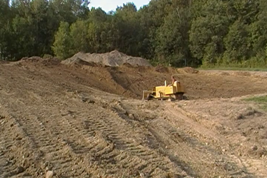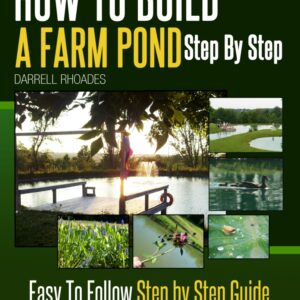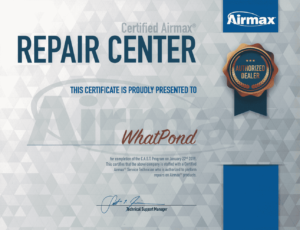 Three important features for pond construction are topography, soil type and water supply.The ideal topography for pond construction is a natural low area or a broad draw with a narrow neck at its lower end, permitting runoff and springs to be impounded with a short dam across the neck. The most economical pond construction site will impound the largest amount of water, with the smallest dam.
Three important features for pond construction are topography, soil type and water supply.The ideal topography for pond construction is a natural low area or a broad draw with a narrow neck at its lower end, permitting runoff and springs to be impounded with a short dam across the neck. The most economical pond construction site will impound the largest amount of water, with the smallest dam.
Soil Type
Pond construction for the dam, sides and bottom should be composed of soils that contain enough clay content. Properly compacted to provide a water tight basin, with no woody or organic material. Spread thin layers, approximately 6” thick and thoroughly compact, depending on the equipment used.
Pond Construction And Water Supply
The ideal watershed should keep the pond full at all times. Ideally springs or small seeps are the best source, they provide cool,clean, unpolluted water, but much in the way of supplying oxygen. But be careful these springs and seeps can also act as drain in the summer months. The runoff should come from tree cover or grassland. This will help filter silt and other pollutants from entering.
Pond Construction Of The Dam
The top of the dam should be 8′ wide for a depth less the 10′ and 12′ wide, going 20 to 25 feet deep. The slopes of dam side and grass side should be 3:1 minimum. 4:1 on grass side will be easier to mow. The top of the dam should be at least 12” above the overflow pipe level to help prevent waves and floods from over flowing the dam. 
- In pond construction terms this brings us to the mechanical spillway. Known as the overflow pipe or trickle tube. This maintains the the normal water level of the pond. It permits regular overflow to escape with out using the flood or emergency spillway. The top of the overflow pipe should be six inches to one foot below the emergency spillway. Pipe size should permit that the level returns in 24 hours. The over flow pipe can be combine with a drain tube. Having a drain tube allows the pond to be drained to either make repair if a leak should occur or to remove undesirable fish populations. With any pipe going through the dam the use of a anti seep collar should be placed 10 to 25 feet apart. Decide if you want a drain before starting the pond construction.
Pond construction And The Spillway.
The purpose for the flood or emergency spill way is to safely remove excess water during heavy rains. It should be big enough to handle the 25 year rain. Wide and shallow works best , this allows the maximum flow and the least amount of fish loss. The spillway should be gentle sloping away from the pond. Can be seeded for grass, cement, anti erosion screen or rocked to help prevent erosion. Do not screen the spillway in an attempt to save fish. It is cheaper to lose a few fish than to lose the dam.
Plan your pond construction carefully.
Learn more about the different types of ponds with our Definitive Guide to Ponds, Free,
Or if you are ready to to get started building your pond and need all your questions answered about the process purchase our E Book, “How to Build a Successful Farm Pond” and download it today.



I have 200 acres of land that drian directly through my property.I want to biuld a dam that is 270 wide & approx. 14 tall that will give me a 5 acre pond .How do I get correct pipe size.Where do I purchase an overflow that I can Use.My soil co. says that is a tremendious amount of water & I need to build a perfect dam.I need all the info I can get?
Hi Grant, great questions and thank you for asking. I have a couple questions for you to help provide the info you need and
locate a couple more resources for you.
200 acres of watershed certainly will provide plenty of water. What part of the country is your property?
Do you have winter’s with snow? How much snow fall if any?
Not only the correct size overflow pipe but building a proper size emergency spillway is important too.
Darrell Rhoades
I’m almost finished clearing the trees that I cut down for my future pond.Waiting on a “bid” from a local heavy eqip. contractor for stump removal & digging.My land is in southern Illinois at Shawnee Nat. Forest.The soil is almost 100% clay.With compaction from the dozer,will I need to add or do anything to prevent leakage,once the hole is done?
I currently have a pond of ~1 acre that has a “natural drainage” overflow. I would like to install a “pipe” overflow such as a 15″ pipe with a 90 degree ell as the “trickle” overflow. I want to do this in order to raise the level of the pond also. Do you have any piping design for this. I do not want to drain the pond to install conventional overflow pipiing.
You have to be careful when building a dam. Dam construction is regulated by your local state ordinances. Usually your Dept. Of Natural Resources. Even a small dam can be considered a Class I high hazard depending on the watershed (amount of upstream terrain) and what lies beyond the dam. If you are a Class I, all kind of appurtenances come into play. Dewatering valves, emergency spillways, hydrology studies, emergency action plans and so on. If you build one without a permit and your local water authority find you, you will be looking at fines, attorney fees and most likely in the end, a court order to tear down your dam. So do yourself a favor and check first. Google ASDSO and on their site, find your local state water authority and save yourself a lot of trouble. My HOA did this in the mid 70’s (way before I moved here) and we are now looking a a half-million dollar project for a 5 acre pond!
I an in central N.C. I also have 200 acres of forest and some housing and business (about 30 acres) draining onto my property, I want to build a 1 acre pond. What size overflow pipe do you think would work for that application. Thanks
I an in central N.C. I also have 200 acres of forest and some housing and business (about 30 acres) draining onto my property, I want to build a 1 acre pond. What size overflow pipe do you think would work for that application. Thanks
Sorry, e-mail listed in prior post was incorrect.
i have a dozer and want to build a farm pond but would like to find a free online video that shows a step by step construction.i am an excavator operator but my skills with a dozer are limited to mudslides and pushing shot rock where i can reach it with the trackho.can you help me.
Hello Lucas, I have not seen any free online videos for a step by step construction. I do have a book that walks you through the process as I built my own pond but that is 27 bucks.
You can also go to the blog and start way at the beginning as most of the book comes from the blog. I do have videos of the second pond I built on the property but have had no time to start editing and compiling all the clips together. If you have specific questions please list them and send to [email protected]. Hope this helps
I have no tube in my pond just a spillway that has been rocked will it wash away?
I would like to build a pond on my property in Wattsburg. The soil at the site is Fredon Loam. Is that soil suitable for ponds?
My neighbor has a lake with two overflows,one is concrete and one is in the lake.the one in the lake is leaking.he would like to eliminate it,what is the simplest way.this over flow has a screw valve enclosed in a circular metal overflow it is rusty and leaking water through a concrete tile into a swamp.what are his options?
Hello James,
For your friends pond I assume the cement over flow is the emergency spillway?
If so, the cement should be checked out to be sure it will be able to handle all the water the current metal pipe used to handle plus an extreme rain or snow melt events.
I’ve not repaired a pipe like this but after seeing some of the methods they do scare me a little.
One thought is to install a plastic pipe inside the metal pipe and pour cement in between the two pipes. But having a valve in the mix will prevent this so called fix.
Another thought is to just fill the pipe with cement to eliminate the overflow. Question here is how big of diameter is the pipe and the total length down and out is the current pipe to figure out how much cement is needed. Plug up the outlet and call in a pumper truck.
Make sure in any case that where the pipe going the dam is sealed again, even if cemented in and not in use the outside diameter can allow water to seep out which that leak will get bigger over time. Find some local clay and place it around the pipe on the water side of the dam, about a foot thick or more, sort of like a patch. If no clay can be found check out the Pond Seal page for the audio, https://www.whatpond.com/pondseal/ Or send us an email with the pipe diameter, location and we’ll figure out how much is needed and costs.
I would still add a new overflow pipe instead of using the emergency spill way for the water to leave the pond. Over time there is a lot of water flow leaving the pond and if the spillway is not built large enough or strong enough it will be the next potential leak point, possible erosion which could become a dam failure. It doesn’t have to go to the bottom of the pond but at least down below the frost line 3′ minimum depth.
Hope this helps?
Be careful and caution anyone downstream.
Darrell Rhoades
Hi Darrell, Thank you for your very helpful website and knowledge. We have a pond that is 50 years old and approximately 2 acres when full. It has been in decline for several years. We are about to bite the financial bullet and have the pond dam rebuilt and the trees removed from behind the dam. We are in need of a new drainage system, overflow. One can be provided but at a cost of $3000. Can I buy one for less or could I assemble one myself?
Thanks, Terry
Hi Terry, One of the most important parts of the pond is for the excess water to escape. It can be from the over flow pipe, https://www.whatpond.com/2009/08/pond-water-exit/ or the emergency spillway which is equally important, https://www.whatpond.com/2009/04/pond-emergency-spillway/
The over flow or stand pipe handles the normal rain as the pond fills and if it happens to plug or can’t handle the incoming water the spillway will take the excess water.
All this the sizing really depends on the size of watershed coming into the pond. A pond that is small does not mean it needs a small spillway or over flow pipe if the acreage above the pond can be more than the pipe can handle. Look at Colorado and the recent abnormal rains, we want to size and prepare for these potential storms and or snow melt and spring rains.
If you think the spillway is big enough, make it bigger, better safe than sorry.
Darrell,
Please allow me to use this “review” box to ask my own concern. Two years ago we acquired a small, 1/4 to 1/2 acre spring-fed pond but have never seen water flow over the spillway/dam, even during excessive, abundant rains.
Had two pond people over & the first suggested he install a 12″ PVC overflow pipe & replace the crudely build concrete dam, filling in the drain ditch that has never drained anything during our ownership. The second guy sent his helper down into the creek behind the dam and he reported a big leak from underneath the dam. I like the idea of a big overflow pipe to remove leaves and small debris from the surface, and it could run through a new 12″ x 16 foot long dam replacement. Distance from dam to creek less than 20 feet. We have plenty of clay soil to pack around a new pipe in 6″ depths. Might we go ahead with the overflow pipe, eliminating any spillway, or is this an unsafe idea. There is this levy going around about half the pond, separating it from the creek along side, but terminating about where the current dam is installed.
Any suggestions will be greatly appreciated.
Thanks, Bill